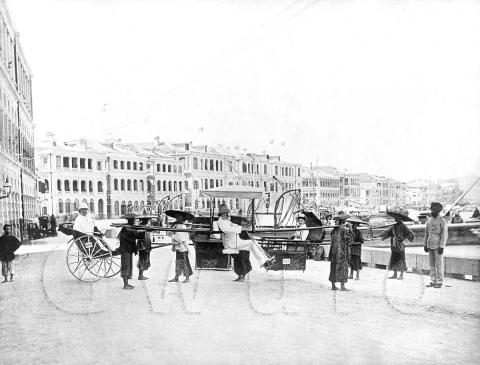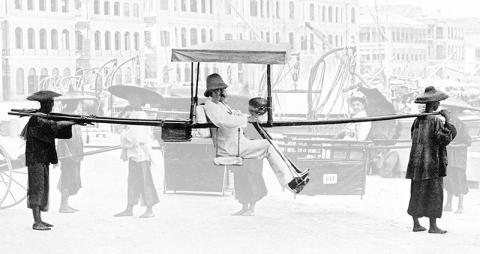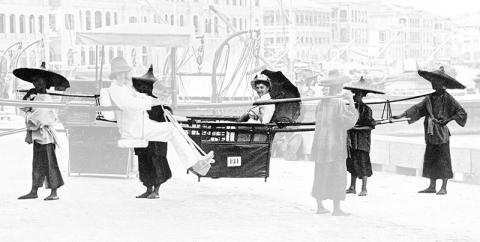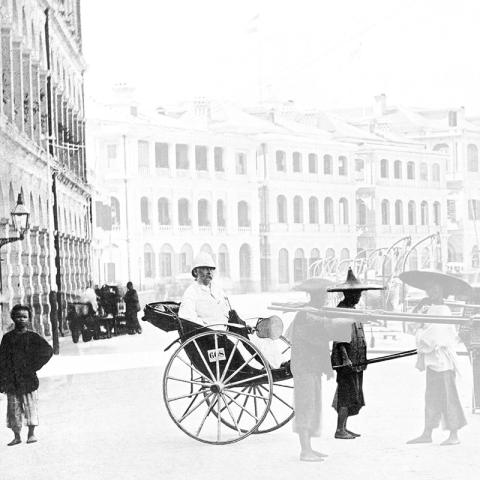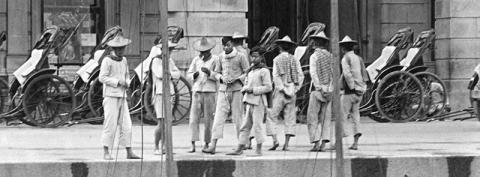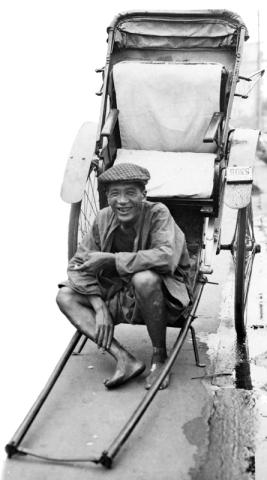About a third of the Illustrated London News (ILN) page is taken up with sketches of what they describe as ‘Jinrickshaws’ and ‘Portable Chairs or Litters’. This photo shows them too, though its title is ‘Jinrickisha and carrying chairs’. Today we call them rickshaws and sedan chairs.
Sedan chairs were the older of the two. The ILN’s readers would have recognised them, but would have seen them as quaint and old fashioned. Sedan chairs had been popular in London in the 1600s and 1700s, but had disappeared from the streets by the mid-1800s.
Sedan chairs had a much longer history in China, and were still in widespread use in the 1840s. They quickly became the standard means of transport in Hong Kong. As seen in the photo above, there were several different styles of chair in use. Front and centre is the chair carrying the bearded man wearing a topee (sun hat).
He’s using the most basic form of chair, a simple seat and footrest suspended from two poles, minimising the weight for the carriers.
Beyond him, the woman is sitting in the more usual type of chair where the passenger sits semi-enclosed. I’m used to seeing her style of chair with the roof and the man’s lighter chair without, but here they’re reversed, with the woman relying on her parasol for shade.
A team of four men carry her chair. Sometimes the larger team was needed to handle a long, uphill climb, but other times it was used as a way to show off the rider’s status. Here’s the Prince of Wales visiting Hong Kong in 1922, his sedan chair carried by a team of eight!
Despite the sedan chair’s early success, they were quickly overtaken by the newly arrived rickshaws. Originating from Japan, the rickshaw first appeared on Hong Kong’s streets in 1874. That was a privately owned vehicle, but it started a trend that led to rickshaws being made available for public hire in 1880.
If you turn back to the ILN sketches and look at the rickshaw on the left, can you spot what is unusual about it?
Those first rickshaws were much wider and, as the ILN sketch shows, could carry two passengers. The government soon issued new regulations that made the rickshaw narrower, so that it could only carry one adult. It would be nice to think this change was made with the rickshaw puller’s welfare in mind, but instead it was done for the welfare of Hong Kong’s roads. The first rickshaws were found to cut up the road surface. The single passenger made the rickshaws lighter which, together with a switch to wider wheels, helped tackle the problem.
As the new regulations were introduced in mid-1882, we’re lucky the artist caught the older model before it disappeared. Then is the rickshaw below one of the new, narrower models? We can’t be sure from this angle, but if it is, it is one of the first: the photo must have been taken before the end of 1882, when the building on the left, Wardley House, was demolished.
The 1880s photo was taken on the seafront when it ran along Des Voeux Road. The men shown below are also on the seafront, but their photo is from the 1920s, when the seafront had moved north to Connaught Road.
Their rickshaw rank stood in front of the original St George’s Building. With several large office buildings nearby, the Star Ferry pier to the left, and Blake Pier to the right, this was a prime location to pick up passengers. The men look to be a tight-knit group, all wearing the same style of hats and clothes. I doubt any unknown rickshaw pullers would have been welcomed here.
This was a problem for new arrivals – how to get started? The lucky ones would arrive with a family connection, ‘Get in touch with third uncle’s son-in-law’. Even without that, there may still be someone from the same village who could help. Failing that they’d have to look for one of the larger groupings, typically of people from the same part of China. Early English-language descriptions of Hong Kong mention ‘Chinatown’, as though the whole Chinese community was one unit. The new arrivals knew better, and would be listening out for a snatch of familiar dialect, identifying the speaker as someone from their district. Once they joined a group, wearing the same style of hat and clothes solidified the group’s identity.
But there’s always one who didn’t get the memo…
These photos and text came from the draft of my new book, Volume 5 of the Old Hong Kong Photos and The Tales They Tell series.
| You can pre-order Volume 5 to get special pricing, free shipping, and signed copies. Click here for details. Offer ends 22 Dec. |
Volumes 1-4 of the book series are available to order from the Gwulo website, in local bookstores, and from Amazon (affiliate link).
Further reading on Gwulo:
